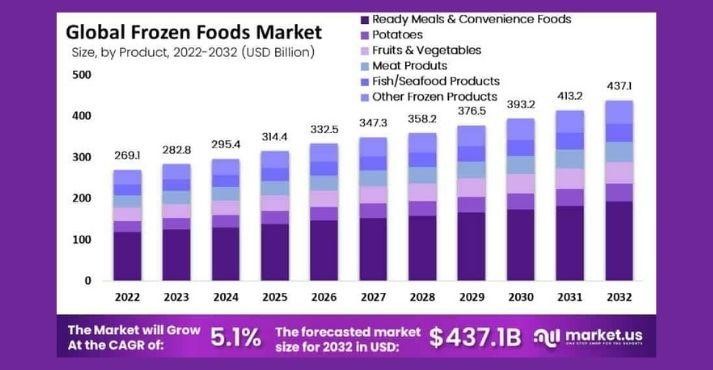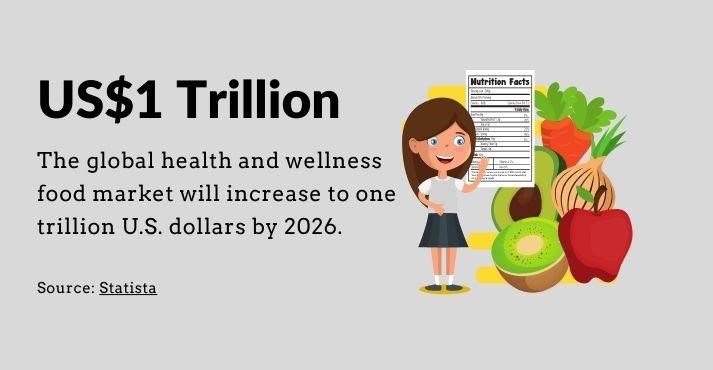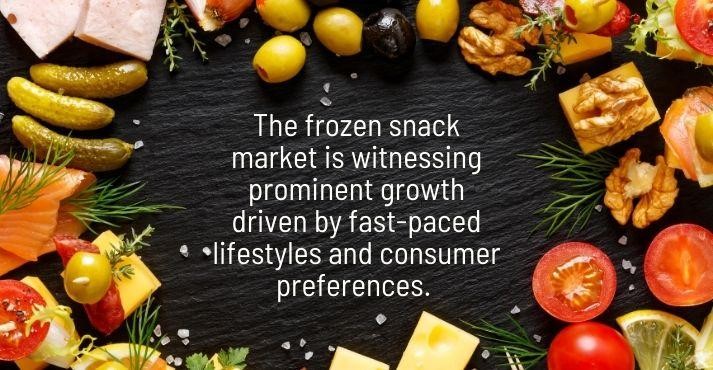Demand for convenience related to food is on the rise.
In the fast-paced world where no one ever stops, consumers strive for convenient solutions in every aspect of their lives.
Driven by drastic consumer changes, the frozen foods market is growing by 2026, and the market for frozen food is forecast to grow to 366.3 billion dollars.
The fast-paced lifestyle is transforming frozen food market trends and driving growth in the Food and Beverages market.
Overview of the Frozen Food Market
The frozen products market has a sizable target market. According to Fortune Business Insights, the global frozen food market is projected to grow from $297.47 billion in 2023 to $412.93 billion in 2030.
The global frozen food market includes items such as:
- Ready meals and convenience foods
- Potatoes
- Fruits & vegetables
- Meat products
- Fish/Seafood Products
- Other frozen products
The key competitors in the frozen food market industry are:
- Unilever
- Nestle SA
- General Mills
- Nomad Foods Ltd
- Tyson Foods Inc.
- Conagra Brands Inc.
With strong support for technological innovation and the advantages of frozen food products, these factors contribute to an increase in frozen food purchases, thus fueling the market growth.

Source: GlobeNewswire
Latest Trends in the Frozen Food Market
When discussing the latest frozen food products market trends, we refer to the factors causing the growth.
Let’s explore each of these trends in detail.
1. Rising Consumer Awareness of Online Shopping
As global internet access and adoption rapidly increase, with over five billion internet users worldwide, the number of people making purchases online is ever-increasing. According to the American Frozen Food Institute (AFFI), frozen food is popular in digital carts.
The frozen food products online are increasing due to convenience and eliminating the need for physical store visits. With a few taps on a smartphone, users can access frozen products from the comfort of their homes.
Whether it’s a frozen fruit pack for smoothies or a single-serve healthy meal, the variety of frozen items will help consumers meet their goals. Therefore, to start a food business, you must understand the consumer choices for frozen food shopping.
2. Demand for healthier and more nutritious frozen food options

As per the report by Mordor Intelligence, the demand for organic frozen food demonstrates a CAGR of 4.3% from 2020 to 2025. Also, the global health and wellness food market will increase to one trillion U.S. dollars by 2026.
Consumers and younger shoppers have fueled the trend for organic and better-for-you foods. They are boosting the demand for frozen food businesses, providing healthier and more nutritious food options.
Consumers are trying various diets and lifestyle changes to improve their health, preventing future health conditions.
Health-conscious consumerism extends to the frozen food aisle, with gluten-free, low-carb, high-protein, and clean labels, reflecting the demand for food variety and nutritious options.
3. Growth of plant-based frozen products
The global plant-based food market will reach 77.8 billion U.S. dollars in 2025. With the rising awareness of environmental sustainability and health-conscious consumer choices, plant-based frozen foods have gained popularity.
According to the Good Food Institute, 93% of households that bought plant-based meat also purchased conventional meat in 2022.
Wholesale food suppliers are now stocking various vegan and vegetarian options in the frozen food section to meet consumer preferences.
Frozen food manufacturers are capitalizing on this opportunity, catering to plant-based food consumers with meat alternatives like vegan burgers and meat-less sausages.
4. Higher Demand for Premium Frozen Foods
The demand for premium frozen foods has increased drastically over the years due to evolving consumer preferences for convenient but high-quality meals. Consumers are recognizing premium foods to satisfy their particular lifestyle requirements.
Innovations in gourmet frozen options, health-conscious choices, and improved packaging have driven this expansion. High-income urban households have been the driving factors of these premium products, which are responsibly sourced and provide unique flavors.
The trend towards premiumization accelerated as consumers sought to elevate their at-home dining experiences with superior ingredients and culinary expertise.
5. A New Demand for Frozen Snacks

The global healthy snacks market is expected to grow 6.6% annually between 2022 and 2030. As such, the market should reach 152.3 billion U.S. dollars by 2030.
The frozen snacks market is expanding rapidly due to the increasing number of working populations and their hectic lifestyles. Frozen snacks are more consumers than ever, as they are a more accepted part of diets.
As snacking is becoming more desirable daily, consumers are getting more selective about their snacks. It has led to innovation in the sector, such as desserts, nuggets, taquitos, jalapeño poppers, and quiches.
Consumers have taken a long-term and holistic approach to snacking, as they have become more mindful of what they eat but are still willing to indulge.
6. Sustainable and eco-friendly packaging solutions
Consumers continue to seek greater food transparency and a demonstration of sustainably sourced ingredients.
According to a study by Business Wire, consumers based on generations, countries, and industries differ in attitude, but 85% of them have become greener, increasingly becoming environmentally conscious in recent years.
The frozen food items industry is no exception, and the frozen food packaging market is expected to reach a value of USD 56.2 million by 2026, at a CAGR of 5.18% over the forecast period (2021 – 2026).
Many business owners managing hotel food and beverage services embrace sustainable, eco-friendly packaging solutions. It increases brand awareness, reflects a commitment to reducing their environmental footprint, and meets the growing consumer demand for eco-conscious choices.
Asia-Pacific: Fastest Growing Region for Frozen Food Market
Asia-Pacific’s frozen food industry is projected to register a CAGR of 6.8% during the forecast period 2022-2027. The market is driven by growing consumer interest due to hectic lifestyles, expanding working women population, and preferences for ready-to-cook frozen foods.
Also, technological innovations have resulted in the affordability of frozen food in the Asia-Pacific market. Also, increasing urbanization and the drastic shift in dietary habits are likely to boost the growth in the frozen food market.
Additionally, the rising demand for dairy products in the Asia-Pacific region, such as natural snacks, yogurt, and sour milk, is driving the growth of the frozen food market in the region.
Therefore, F&B businesses need to attend the F&B exhibition to stay ahead of the latest trends and technologies in the industry.
Frozen Food Market Trends (FAQs)
How much is the frozen food market worth?
The global frozen food market size was estimated at US$ 322.49 billion, and it is projected to surpass around USD 612.28 billion by 2032, with a registered CAGR of around 4.6% from 2023 to 2032.
Which is the leading product type in the frozen food market?
The leading product types in the frozen food market include:
- Frozen potatoes
- Frozen vegetables
- Frozen ready meals
- Frozen seafood
- Frozen snacks (e.g., mozzarella sticks)
- Frozen desserts (e.g., ice cream)
Which is the key factor driving the frozen foods market?
The key factors driving the frozen foods market include:
- Changing lifestyles
- Longer shelf life
- Convenience
- Product innovation
- Plant-based options
- Urbanization
- Sustainability
Closing Thoughts
The frozen food market is in the midst of a transformation driven by trends reshaping the industry. These top 6 trends in the F&B sector discussed above show no signs of disappearing. They are set to become more pronounced in the coming years.
While the frozen food industry is poised to grow, diversifying product ranges to include more plant-based and premium meal options should be a natural area of priority for such businesses.
Lastly, the players in the industry need to stay updated with the latest trends in Asia’s food and beverage industry in 2023 to assess the risks and opportunities they present. The ability to adapt to consumer choices in the frozen food market will define the way forward.





























